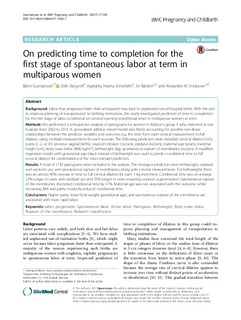| dc.description.abstract | Background
Labor that progresses faster than anticipated may lead to unplanned out-of-hospital births. With the aim to improve planning of transportation to birthing institutions, this study investigated predictors of time to completion for the first stage of labor conditional on cervical opening (conditional time) in multiparous women at term.
Methods
We performed a retrospective analysis of partograms for women in Robson’s group 3 who delivered at one hospital from 2003 to 2013. A generalized additive mixed model was fitted, accounting for possible non-linear relationships between the predictor variables and outcome, e.g. the time from each cervical measurement to full dilation, using multiple measurements for each woman. The following predictors were included: cervical dilation (cm), parity (1, 2, or ≥3 previous vaginal births), oxytocin infusion (no/yes), epidural (no/yes), maternal age (years), maternal height (cm), body mass index (BMI, kg/m2), birthweight (kg), spontaneous rupture of membranes (no/yes). A modified regression model with gestational age (days) instead of birthweight was used to predict conditional time to full cervical dilation for combinations of the most relevant predictors.
Results
A total of 1753 partograms were included in the analysis. The strongest predictors were birthweight, epidural and oxytocin use, and spontaneous rupture of membranes, along with cervical measurements. For birthweight, there was an almost 40% increase in time to full cervical dilation for each 1-kg increment. Conditional time was on average 23% longer in cases with epidural use and 53% longer in cases requiring oxytocin augmentation. Spontaneous rupture of the membranes shortened conditional time by 31%. Maternal age was not associated with the outcome, while increasing BMI and parity modestly reduced conditional time.
Conclusions
Higher parity, lower fetal weight (gestational age), and spontaneous rupture of the membranes are associated with more rapid labor. | nb_NO |

